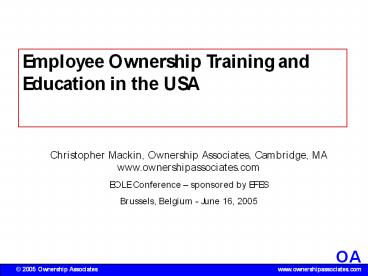Employee Ownership Training and Education in the USA - PowerPoint PPT Presentation
Title:
Employee Ownership Training and Education in the USA
Description:
Employee Ownership Training and Education in the USA Christopher Mackin, Ownership Associates, Cambridge, MA www.ownershipassociates.com EOLE Conference sponsored ... – PowerPoint PPT presentation
Number of Views:125
Avg rating:3.0/5.0
Title: Employee Ownership Training and Education in the USA
1
Employee Ownership Training and Education in the
USA
Christopher Mackin, Ownership Associates,
Cambridge, MA www.ownershipassociates.com EOLE
Conference sponsored by EFES Brussels, Belgium
- June 16, 2005
2
Involvement is not inevitable.
Expectations about involvement are inevitable.
3
Four Steps toward the creation of an Ownership
Culture
- Set the Context
- Build Skills
- Agree on Meaning - Narrative
- Initiate Organizational Change
4
Four Steps toward the creation of an Ownership
Culture
- Set the Context Why is the seller selling to
employees? - Build Skills - Foster the development of
ownership skills concerning how your employee
ownership structure works and how your business
works. - Agree on Meaning Construct your theory of what
ownership means your ownership narrative. - Initiate Organizational Change - Initiate a
process of organizational change Becoming a
Company of Owners
5
1. Set the Context
6
Why did the Sellers choose to sell to employees?
7
The Transaction Option A
Founding Shareholders Smith and Others
What happens to OurCo, Inc.? OurCo
Employees? Our OurCo Culture?
8
2. Build Skills
9
Four Stages of ESOP Participation
Allocation
Participation
Vesting
Distribution
10
Stage 2 Allocation
Eligible Payroll
and John earns 20,000.
11
3. Agree on Meaning
12
(No Transcript)
13
(No Transcript)
14
(No Transcript)
15
(No Transcript)
16
4. Initiate Organizational Change
17
unpublished data from the Ownership Culture
Survey
18
Standard List of Corporate Decisions
- 1. Physical Working Conditions
- 2. Election of Employees Committee
- 3. Speed of Production
- 4. Job Assignments
- 5. Safety Rules and Practices
- 6. Quality Standards and Measurement
- 7. Hiring
- 8. Promotions, Performance Evaluation
- 9. Equipment Layout
- 10. Asset Purchases
- 11. Employee Compensation and Benefits
- 12. Firing
- 13. Marketing and Advertising Strategies
14. Raising Capital, Relationships with Banks and
Investment Groups 15. Product, Technology, and
Investment Strategy 16. Lay-off Policy,
Employment Levels 17. Management
Compensation 18. Distribution of Profits
(dividends, reinvestment, debt reduction) 19. Sele
ction and Oversight of Senior Management 20. Const
itutionalism Setting and Moving Decision-Making
Boundaries 21. Selection of Board of
Directors 22. Fate of the Company merger, sale,
major location change
19
(No Transcript)
20
(No Transcript)
21
(No Transcript)
22
23
Questions and Answers































